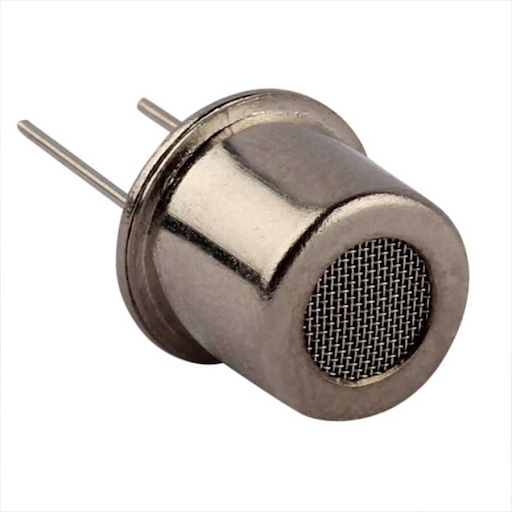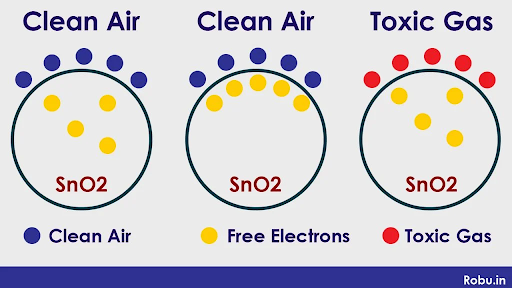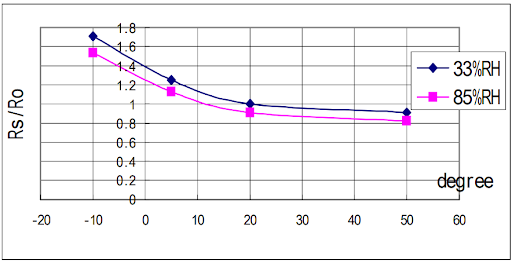
Good day peeps! Welcome to another episode of the MQ gas sensor series and today, the topic is the MQ214 natural gas sensor. We know that natural gas is inflammable and is utilised widely for cooking and other purpose in domestic areas as well as a fuel in multiple industries. The leakage of natural gas can be the reason for the accidents and its accumulation may even result in the explosion. Moreover, continuous inhalation of this gas can cause health issues such as nausea, dizziness, and headaches therefore, instant detection of its leakage is crucial. For this, one of the best options is MQ214 because it has a fast response time, low power consumption and is easily available.
In this article, we are discussing the fundamental points about this sensor. We’ll see its basic introduction and will see the basic components to see its features. After that, we’’ go through some points of its datasheet. Following this, we will explore the working principle and physical dimensions of the sensor and consequently, we’ll see some important applications where this sensor is widely used. Let’s move towards the first point:

MQ214 Natural Gas Sensor Introduction
The detection of natural gas leakage is important because every year, multiple accidents are seen because of the undetectable presence of natural gas. The MQ124 is a member of the MQ sensor series which is utilised to detect natural gas (which primarily consists of methane (CH4), in different projects. It has the features like a simple structure, easy installation, instant performance and reliability that make it a popular choice. Moreover, it has a good sensitivity to other gases as well but in this article, our focus is the main target gas (natural gas). Some important gases that MQ124 detects are:
- Carbon Monoxide (CO)
- Methane (CH4)
- Liquefied Petroleum Gas (LPG)
- Hydrogen (H2)
- Alcohol (C2H5OH)
- Smoke
MQ214 Natural Gas Sensor Basic Structure
Now, you will see the important components of this sensor that collectively create the MQ124 natural gas sensor:
MQ214 Natural Gas Sensor Ceramic Tube
The ceramic tube acts as the base for the sensing element and plays a role in the better performance of the sensor. It is made of alumina (Al2O3) and has good thermal and electrical resistance as well as chemical inertness which makes it a perfect choice for this role. This provides mechanical strength to the sensing element and does not cause any change in its performance.
MQ214 Natural Gas Sensor Sensing Element
Usually, metal oxides are used in such cases because of their chemical properties and in most of the MQ gas sensors, including MQ124, tin oxide (SnO2) is used as the sensing element. It is present in the form of a uniform layer around the ceramic material and absorbs the gases to perform its duty. It acts as the heart of the MQ124 natural gas sensor and provides reliable performance.

MQ214 Natural Gas Sensor Heating Circuit
The sensing element alone can not show the best result until the heating sensor does its work. It raises the sensing element temperature to the optimal range and stimulates it to absorb the gas. The main heating element in this structure is made with the resistant wire (usually made of nichrome. Other components of this circuit are:
- Power supply
- Temperature Control
- Protection Circuitry
- Wiring and Connectors
MQ214 Natural Gas Sensor Housing and Base
The housing and base of the MQ124 sensor serve as both a support structure and a shield, ensuring the circuit's integrity and protecting it against external factors. The following points will help you to understand their role:
- These are made with heat resistance and reliable materials such as plastic, metal, or bakelite that protect the internal circuit from heat and environmental factors.
- The housing encloses the delicate internal structure and acts as a protective barrier against dust, moisture, and other contaminants.
- The housing is perforated and allows the gas only to pass through it.
- Depending on the model of MQ214, the base may have mounting holes or brackets for easy installation.
- In addition to this, the base may also have labels, wire entry points, ventilating points, etc.
MQ214 Natural Gas Sensor Datasheet
The datasheet is an important document that represents the technical information of the devices. Here are some important points that highlight basic information about MQ214:
MQ214 Natural Gas Sensor Features
It has a high sensitivity to natural gas and, therefore, has a very low response time.
It has tin oxide (a metal oxide) for sensing the target gas therefore providing accurate and reliable output.
The wide range of 200 to 10000 parts per million (ppm) of this sensor makes it an ideal option for detection.
It has adjustable laid resistance.
This sensor has a temperature range of -10°C to 50°C and shows flexibility in the designing process as well.
MQ214 Natural Gas Sensor Specifications
The following is the outline of the technical specifications of the MQ214 natural gs sensor:
Parameter |
Specification |
Model |
MQ214 |
Detection Gas |
Natural Gas (CH4) |
Sensing Method |
Semiconductor |
Heater Voltage (VH) |
5V ±0.2V |
Operating Voltage (V) |
5V DC |
Load Resistance (RL) |
Adjustable |
Heater Resistance (RH) |
33Ω ±5% |
Sensitivity |
≥3.5%RH/CH4 |
Sensitivity Range |
200-10000 ppm |
Preheat Time |
≥48 hours |
Response Time |
≤10s (preheat time excluded) |
Recovery Time |
≤30s (preheat time excluded) |
Heating Power |
<900mW |
Working Temperature |
-10°C ~ 50°C |
Circuit |
High Sensitivity |
MQ214 Natural Gas Sensor Sensitivity Characteristics
This sensor can detect multiple gases at a time but has the most sensitivity to natural gas. Here is the sensitivity characteristic graph of this sensor for different gases that shows the comparison:

MQ214 Natural Gas Sensor Temperature/Humidity Curve
The temperature has a major role in the performance of this sensor therefore, always have an eye on the temperature and humidity graph before using it. Here is the graph that will show you its performance at varying temperatures and humidity:

Here,
- Ro shows the sensor resistance at 1000ppm of i-butane in the air at 33% RH by keeping the temperature at 20 degrees.
- Rs shows the sensor resistance at 5000ppm of CH4 at different temperatures and humidities.
If you are interested to know more about the MQ214 datasheet, you can visit the following link:
MQ214 Natural Gas Sensor Pinout Configuration
The pin configuration of the MQ214 Natural Gas Sensor follows the same pattern as other sensors within the MQ gas sensor series. Below is a table presenting all the relevant details:
Pin Number |
Function |
Description |
1 |
VCC (Voltage Supply) |
It provides power to the sensor and is connected to a positive voltage source |
2 |
GND (Ground) |
This pin is the ground connection for the sensor hence is connected to the negative terminal or ground of the power supply |
3 |
AOUT (Analog Output) |
This provides the analogue output signals that are directly proportional to the detected gas concentration. |
4 |
DOUT (Digital Output) |
It provides a digital output signal and, therefore, indicates the presence of gas above a certain threshold level set before. |
5 |
H (Heater) |
It is connected to a heating element within the sensor for heating the sensing element (not present in all models) |
MQ214 Natural Gas Sensor Packages
Package Type |
Description |
Common Use Cases |
Through-Hole |
It is a simple component with exposed pins for easy connection and is the most common package |
Prototyping on breadboards Educational projects |
TO-39 |
Metal can be packaged with potential glass window |
Industrial applications |
TO-5 |
It is similar to TO-39 with different form factor |
Industrial applications |
SMD (Surface Mount Device) |
It is a compact package for automated assembly |
Integration into Printed Circuit Boards (PCBs) |
MQ214 Natural Gas Sensor Alternatives
The MQ214 is a popular choice for natural gas detection but it has some limitations. if you want to know some alternatives for the Same target gas then here is the list of these:
Electrochemical Sensors
Figaro TGS series (e.g., TGS813 for methane)
Sensirion SGP series (e.g., SGP30 for various VOCs)
Infrared (IR) Sensors
Shinyei PPD series (e.g., PPD-420 for methane)
Metal Oxide Semiconductor (MOS) Sensors (Alternatives to MQ-214)
Figaro TGS2600 series (wider range of detectable gases)
Figaro TGS822 (hydrogen-specific)
Catalytic Bead Sensors:
Figaro TGS6810 series
As mentioned before, natural gas is mainly methane so the list contains specialized sensors for detecting it. Other sensors can detect multiple gases including methane.
Where to Buy MQ214 Natural Gas Sensor
Always get sensitive devices from a reliable source. Here is the list of the sources where millions of products are present with the best quality and price:
eBay
AliExpress
Amazon
MQ214 Natural Gas Sensor Working Principle
The main principle that MQ124 follows when working to detect the target gas is the chemiresitor and it is defined as:
The chemiresistor is the mechanism of the metal oxide gases in which when they absorb a particular gas their electrical resistance increases.
The output on the MQ124 is obtained by following the steps given here:
- When the sensor is powered on, the heating circuit starts its work and the temperature of the sensor increases gradually until it reaches 300 C.
- At this temperature, the sensing element is stimulated to absorb the oxygen from its surrounding air. The chemical reaction creates the oxygen ions and as a result, a thin depletion layer is accumulated around the sensing element.

- The depletion region results in the increase of electrical resistance. The analogue values of this resistance are sent through the analogue pin. At this point, the mQ214 is ready to detect any target gas.
- If there is a leakage of the gas around it, the depletion region around the sensing element starts reacting with it and it results in the absorption of the region. As a result, the electrical resistance change decreases and more current passes through the circuit.
- The sensor measures the conductivity and changes it into an electrical current. The magnitude of this current is directly proportional to the gas concentration. These values are sent continuously to the analogue pin.
- If the threshold value is set before, once reaching it will cause the sensor to send the signal to the digital pin.
As a result of this flow, the target gas, along with its magnitude is sensed through the MQ214.
MQ214 Natural Gas Sensor Physical Dimensions
Below is the table that shows the general dimensions of the MQ214 natural gas sensor. Keep in mind that these may vary from model to model but the typical values are shown here:
Dimension |
Typical Value (mm) |
Length |
28 |
Width |
20 |
Height |
15 |
MQ214 Natural Gas Sensor Applications
Natural gas is widely used in different domains of life therefore, this sensor has a wide scope. Here are some important projects in these domains that will highlight the importance of this sensor:
Home Safety and Monitoring
Smart Home Gas Leak Alarm
DIY Air Quality Monitor (Combustible Gases)
Industrial Applications
Industrial Gas Leak Detection System
Combustible Gas Level Monitoring for Production Lines
Environmental Monitoring:
Portable Methane Detector for Environmental Research
Community Air Quality Monitoring Network
Hence in this way, we have seen the fundamental knowledge about the MQ214 natural gas sensor. We started the discussion with its basic introduction and saw the basic elements that collectively create this sensor. We also saw the important points from its datasheet such as its features, specifications, and some important graphs. The working principle was also discussed in detail here and in the end, we also saw the physical dimensions and applications of this sensor. I hope I have covered all the points but if you are curious in more detail, you can ask in the comment section.



